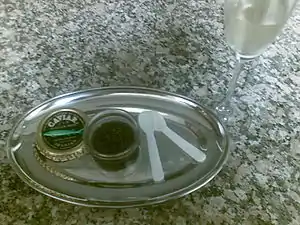Ossetra
Ossetra (also Oscietra, Osetra, or Asetra) caviar is one of the most prized and expensive types of caviar[1] (eclipsed in price only by Beluga caviar). It is obtained from the Ossetra sturgeon which weighs 50-400 pounds and can live up to 50 years.

Ossetra caviar varies in color from deep brown to gold. Lighter varieties are more sought after, as they have the richest flavor and come from the oldest of sturgeon. Golden Ossetra is a rare form of Ossetra caviar, and is golden-yellow in color with a very rich flavor.[2]
The word Ossetra is the transcription of the genitive case form "осетра" (osetra, 'of sturgeon') of the Russian word "осётр" (osyotr 'sturgeon') from the phrase икра осетра (ikra osetra, 'caviar of sturgeon'). At one time, the term "ossetra" simply referred to Russian sturgeon species harvested for this type of caviar.
Source animals
In Russian, there are different names for the species of sturgeon that live in various territories such as Beluga (Huso huso), Sevruga (Acipenser stellatus) and Sterlet (Acipenser ruthenus). The name Ossetra corresponds to the species Acipenser gueldenstaedtii, which is much smaller than Beluga sturgeon (Huso huso), and has a firmer texture. In the territory of the Russian Federation dwells another type of sturgeon, Siberian sturgeon (Acipenser Baerii), which is farmed all over the world because it can adapt to a wider range of habitats. It begins to produce caviar faster than Acipenser gueldenstaedtii.
Production
Today, Caspian Ossetra is facing extinction in its native habitat due to the fact that wild caught sturgeon are immediately slaughtered to determine their sex and egg-bearing condition. If male they have no eggs, and even if female they may not be in roe. Farm raised sturgeon by contrast are periodically scanned by harmless ultrasound to make the same determination. Continuous drastic declines in natural sturgeon populations over the past 30 years plus a high market demand for caviar have led the way for artificially cultivation of sturgeon for the production of caviar. Russia, Iran, members of the European Union, China and the USA were among the first; however, for the very same reasons countries outside the natural range of sturgeons also became involved (e.g. Uruguay, Arabian countries, Israel, Iran, and more recently Vietnam).
As with all other caviars, ossetra is traditionally served on blinis with crème fraiche, chopped hard boiled egg whites and chopped onions. Lower-grade varieties of caviar are used as stuffing in many seafood dishes, and some meat dishes. Caviar is often added to salads as well.
References
- "Osetra Caviar, Siberian Caviar, Baerii Siberian Caviar, Russian Caviar - Gourmet Food Store". www.gourmetfoodstore.com.
- "Ossetra caviar".